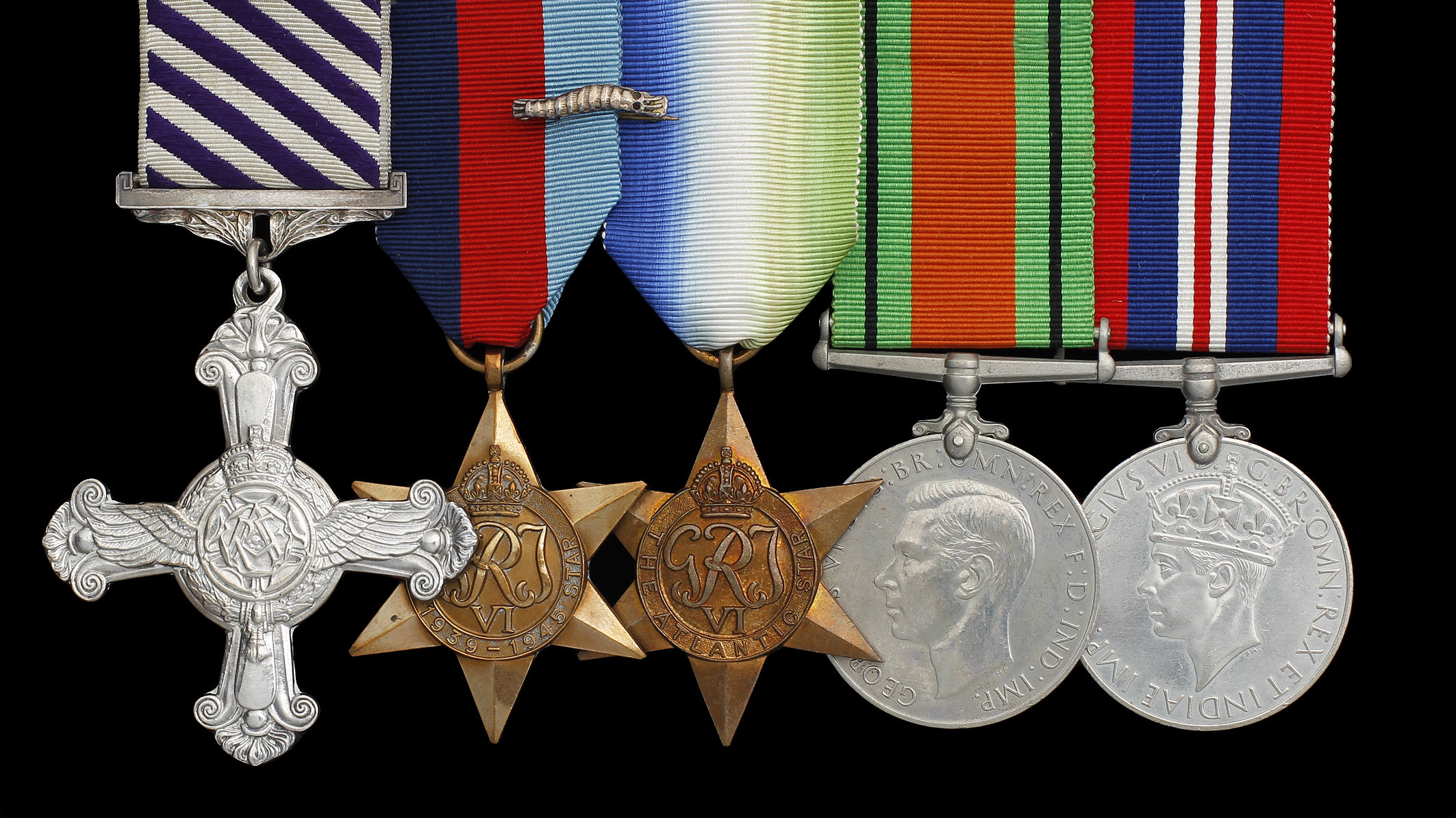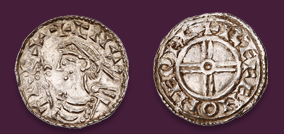
Auction: 11010 - Orders, Decorations, Campaign Medals & Militaria
Lot: 15
Family Group: A Good Second War 1943 Liberator Pilot´s D.F.C. Group of Five to Flight Lieutenant G.B. Willerton, Royal Air Force Volunteer Reserve; A Veteran of the 1,000 Bomber Raid Over Bremen, and a Member of Both the Caterpillar and Goldfish Clubs, He Was Shot Down Over the Bay of Biscay, 13.5.1943, and Survived For Six Days Without Food or Water Until Finally Rescued a) Distinguished Flying Cross, G.V.R., reverse officially dated ´1943´ and privately engraved ´F/O G.B. Willerton´, in Royal Mint case of issue b) 1939-1945 Star c) Atlantic Star d) Defence and War Medals, extremely fine, with the following related items: - The recipient´s Caterpillar Club badge, lacking one ´ruby´ eye, reverse engraved ´Sgt. G.B. Willerton.´, together with a Caterpillar Club tie - The recipient´s Goldfish Club cloth insignia and membership card, named to ´F/O. G.B. Willerton´ - Two Flying Log Books, covering the period 17.9.1940-23.12.1946 - Three Personal Flying Log Books, covering the period 20.12.1946-10.7.1972 - Air Council enclosure for the Second War campaign medals - Telegram to the recipient´s wife informing her that Flying Officer Willerton is missing, dated 14.5.1943 - Letter to the recipient´s wife from the Squadron Commanding Officer following Willerton being reported missing, dated 16.5.1943 - Two Telegrams to the recipient´s wife informing her that Willerton has been rescued, dated 19.5.1943 - Central Chancery letter to the recipient regarding his D.F.C. Investiture, dated 10.11.1944 - The recipient´s riband bar, R.A.F. Wings, cap badge, and other cloth insignia - The recipient´s Prayer Book - Various newspaper cuttings regarding the award of the D.F.C. - Photograph of the recipient - Signed photograph of the crew of Sunderland "S" which rescued the recipient, dated 19.5.1943 - A glazed and framed caricature of the recipient, entitled ´George´, and dated 1944 - The recipient´s wife´s Soldier´s Service and Pay Book Three: Private T.B. Willerton, Army Service Corps 1914-15 Star (R4--062986 Pte. T.B. Willerton. A.S.C.); British War and Victory Medals (R4-062986 Pte. T.B. Willerton. A.S.C.), fine, with the recipient´s Silver War Badge, reverse numbered ´59217´, suspension pin repaired, and a silver A.R.P. lapel badge (lot) Estimate £ 2,200-2,600 D.F.C. London Gazette 20.8.1943 Flying Officer George Bertram Willerton (133039), Royal Air Force Volunteer Reserve, No. 224 Squadron. The recommendation states: ´Flying Officer Willerton was captain of a Liberator aircraft set on fire when attacked by five Ju.88s while on anti-submarine patrol over the Bay of Biscay. The aircraft was forced down onto the sea, but although underwater, Flying Officer Willerton managed to crawl through a side window, swim to a floating dinghy, and in a dazed condition pulled aboard two members of his crew with him, one severely wounded. Without first-aid equipment, he dressed his companion´s wounds as well as he could, and then paddled the dinghy for six days before being rescued. For his outstanding courage and fortitude he is recommended for the award of the Distinguished Flying Cross.´ Flight Lieutenant George Bertram Willerton, D.F.C., was born in Keelby, near Grimsby, Lincolnshire, in 1917, the son of Private T.B. Willerton, Army Service Corps, and was educated at Brigg Grammar School, where he captain the school football team in 1934-35. After leaving school he worked for the L.N.E.R. at Brigg and Grimsby, before joining the Royal Air Force Volunteer Reserve in 1939. After training in 1940, he was posted to No. 224 Squadron (Hudsons), based at R.A.F. Limavady, in Northern Ireland, for anti-submarine patrols, before the Squadron moved to R.A.F. St. Eval, in Cornwall, to fly patrols off Brest and to attack shipping off the Brittany coast. On the 27th January 1942, Willerton was undertaking a routine patrol over Northern France: ´Line "C" Patrol- Attacked Enemy Vessels with 4 S.A.P.- hit by Anti Aircraft fire in starboard engine- flying on one engine about 50 minutes until over land then left aircraft by parachute. Landed on Dartmoor. Landed heavily resulting in black eye.´ (Recipient´s Flying Log Book refers). Returning to Northern Ireland in 1942, Willerton continued with the Squadron´s work undertaking anti submarine sweeps and convoy patrols. This routine received a welcome interruption on the 25th June, when the Squadron was called upon to make up the numbers for the third great 1,000 Bomber Raid: ´Bombing Raid on Bremen. Dropped 1300 lbs bombs on target- Flak encountered!´ (ibid). Converting to Liberators the following month, Willerton was Commissioned a Pilot Officer in the Royal Air Force Volunteer Reserve on the 3rd October 1942, being promoted Flying Officer on the 3rd April 1943. Shot Down On the 13th May Willerton was the captain of a Liberator that was engaged in a U-boat patrol over the Bay of Biscay. His crew that day was Sergeant Hoad, Flight Lieutenant Luke, Pilot Officers Barnham and McCall, Flight Sergeants White and Bell, and Sergeant Garoner, together with Lieutenant Church, an observer from the Royal Navy. After taking off at 13:00 hours they had been patrolling for two and a half hours when suddenly they were attacked from all sides by five Ju.88s. Willerton and his crew fought a dogged but determined battle, but the Liberator was badly shot up, with an explosive shell striking her ammunition store and causing outbreaks of fire in the aircraft. So violent were the fires that the gunners had to break off their fight with the enemy in order to quell the flames. Then, with two engines out of action, the Liberator finally crashed into the sea. Although under water, Willerton managed to crawl through a side window, and reaching the surface he spotted the aircraft´s dinghy floating in the water and swam towards it. Then, seeing Lieutenant Church and Pilot Officer Barham in the water, he dragged them into the dinghy. Church´s arm was badly broken, and although Willerton attempted first aid, and dressed his other wounds, he died of his injuries that night, and was buried at sea. Six days later, the Liberator´s dinghy was spotted by an Australian Coastal Command Sunderland flying boat, which, although U-boats had been reported in the area, alighted on the water. By now Willerton and Barham were in the last stages of exhaustion, having suffered a good deal from exposure, hunger, and thirst, and having survived on just 36 malted milk tablets and a bar of chocolate between them. They had been without water for the entire period, and one night had had to cope with waves 30 to 40 feet high. Picked up by the crew of the Sunderland at 11:15, after 139 hours and 45 minutes in the water, they were flown to Plymouth. Tragically, Pilot Officer Barham did not recover from the ordeal and later died in hospital. Willerton himself recorded the incident in his Log Book in rather laconic terms: ´On rover patrol. Took off 13:00. Attacked by 5 Ju.88s and shot down into sea. Self and Barham and Church got into Dinghy. Lt. Church died overnight- buried at sea. Self and Barham rescued by Sunderland "S" after six days in dinghy without food or water. Poor do.´ (ibid). Promoted Flight Lieutenant on the 3rd October 1944, Willerton received his D.F.C. from the King at Buckingham Palace on the 21st November 1944. By the end of the War he had flown 40 different aircraft. After the War he was employed by B.A.O.C., as a Captain flying Comets, Britannias, and finally Boeing 707s, flights which he continued to record in his Log Book. Having taken to the air for the first time for just 25 minutes in a Tiger Moth on the 17th September 1940, his final flight behind the controls was on the 9th to 10th July 1972, when he captained flight BA666 from Los Angeles to London.
Sold for
£3,500




